COMMENT OF THE DAY: IN THE CLEAR WATERS OF THE GULF “I take my kids there every couple of weeks all summer and we are in and out of the water all day. I don’t know what it used to be like in the 80s but when we go to Stewart beach now the water is clear, we see dolphins almost every visit and fish literally swim between your toes periodically. I didn’t go down there for a couple of years after moving out here because of the horror stories I heard. They were nonsense then and they’re still nonsense now.” [Jimbo, commenting on Galveston’s Flagship Hotel Fades into the Sunset, Leaves a Few Big Chunks in the Gulf]
Galveston
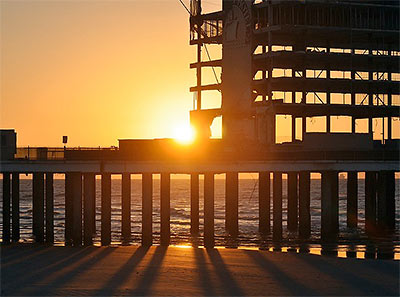
Onlookers are reporting that large portions of Galveston’s Flagship Hotel are finding their way into the water below the 25th St. pier. The hotel’s owner, Landry’s Restaurants, is demolishing the building to make room for an amusement-park-style entertainment complex which you might reasonably assume won’t include any under-the pier attractions. The 225-room hotel closed permanently after Hurricane Ike.
Galveston real estate agent Billy Hill has posted an anonymous eyewitness account that a front-end loader operated by the Grant Mackay Demolition Co. pushed several portions of the building into the bay, including the section of framing that disappeared in the interval between these 2 photos:
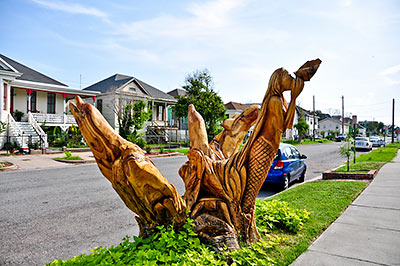
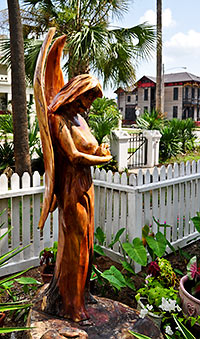 Galveston Mayor Joe Jaworski now says he will waive the $10 annual permit fees the city had planned on charging 3 homeowners whose dead-tree sculptures stand in the public right-of-way. Homeowner Donna Leibbert started a small local-media firestorm late last week after she received a permit renewal form in the mail for the sculpture of a Geisha that artist Jim Phillips had carved out of an oak tree outside Leibbert’s home at 1717 Ball St. After the Hurricane Ike storm surge killed an estimated 30,000 trees on the island, artists turned almost 2 dozen of them into sculptures. But Leibbert’s Geisha is one of only 3 of the works that sits on city property.
Galveston Mayor Joe Jaworski now says he will waive the $10 annual permit fees the city had planned on charging 3 homeowners whose dead-tree sculptures stand in the public right-of-way. Homeowner Donna Leibbert started a small local-media firestorm late last week after she received a permit renewal form in the mail for the sculpture of a Geisha that artist Jim Phillips had carved out of an oak tree outside Leibbert’s home at 1717 Ball St. After the Hurricane Ike storm surge killed an estimated 30,000 trees on the island, artists turned almost 2 dozen of them into sculptures. But Leibbert’s Geisha is one of only 3 of the works that sits on city property.
City spokesperson Alice Cahill, who has helped to publicize the sculpture program as a tourist attraction, tells Amanda Casanova of the Galveston County Daily News that the license-to-use fee is normally required for any designed object that occupies a portion of the right-of-way. “A carved tree is treated the same as a cafe table.” Leibbert tells Casanova she was aware of the permit requirement at the time the Geisha was carved — getting approval for the sculpture required a formal application with the city’s planning commission. But she notes that the tree had stood in the same position for about 100 years, and for free.
Over the summer, Swamplot photographer Candace Garcia tracked down 22 of the tree sculptures, including Leibbert’s Geisha. Here’s her photo tour:
THE SELLOUT CROWD AT PALISADE PALMS 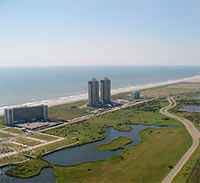 A Florida real-estate developer who bought up 17 condos in the Palisade Palms towers on Galveston’s East Beach at low, low pre-construction prices 5 years ago was finally able to unload 10 of them at an auction earlier this month, taking what he describes as “a 40 percent haircut.“ Mark Shapley tells the HBJ‘s Jennifer Dawson he’s “done in Galveston,” even though he’s still stuck with 3 units in the 287-unit development. (He’d already sold 4 others). Only 50 people showed up to Shapley’s sales event — less than one-tenth of the draw of a June auction where the buildings’ original developer was able to get rid of 27 units. And Shapley sold his units for much less too: from $170,500 for a 1,044 sq.-ft. 2-bedroom to $742,500 for a 2,659-sq.-ft. penthouse. [Houston Business Journal] Photo: Palisade Palms
A Florida real-estate developer who bought up 17 condos in the Palisade Palms towers on Galveston’s East Beach at low, low pre-construction prices 5 years ago was finally able to unload 10 of them at an auction earlier this month, taking what he describes as “a 40 percent haircut.“ Mark Shapley tells the HBJ‘s Jennifer Dawson he’s “done in Galveston,” even though he’s still stuck with 3 units in the 287-unit development. (He’d already sold 4 others). Only 50 people showed up to Shapley’s sales event — less than one-tenth of the draw of a June auction where the buildings’ original developer was able to get rid of 27 units. And Shapley sold his units for much less too: from $170,500 for a 1,044 sq.-ft. 2-bedroom to $742,500 for a 2,659-sq.-ft. penthouse. [Houston Business Journal] Photo: Palisade Palms
BIOSAFETY LEVEL 4, GALVESTON 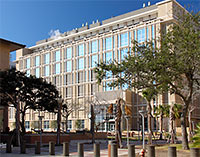 How’s tricks inside the air-tight $174 million Galveston National Laboratory on the UTMB campus, where space-suited investigators get to hang out with anthrax, avian influenza, bubonic plague, Ebola, typhus, West Nile, SARS, drug-resistant tuberculosis, Rift Valley fever and other bad boys? “There’s negative pressure and high air flow. It’s all built to keep stuff inside of the envelope. Animals are housed in containment devices and any individual that comes in must be decontaminated,†director of “high containment facilities” Thomas G. Ksiazek explains to reporter Amanda Casanova: “Construction on the 186,267-square-foot building started in 2005 and scientists moved in earlier this year. In the last few months, there has been only one report of possible exposure to a level 4 agent. In August, an employee stuck herself with a needle of a Central European Tick[-borne] virus while dosing mice, according to a medical branch incident report. The incident was reported to the Centers for Disease Control, and the employee was treated and monitored for three weeks but did not get sick.” [Galveston County Daily News] Photo: Nick Saum [license]
How’s tricks inside the air-tight $174 million Galveston National Laboratory on the UTMB campus, where space-suited investigators get to hang out with anthrax, avian influenza, bubonic plague, Ebola, typhus, West Nile, SARS, drug-resistant tuberculosis, Rift Valley fever and other bad boys? “There’s negative pressure and high air flow. It’s all built to keep stuff inside of the envelope. Animals are housed in containment devices and any individual that comes in must be decontaminated,†director of “high containment facilities” Thomas G. Ksiazek explains to reporter Amanda Casanova: “Construction on the 186,267-square-foot building started in 2005 and scientists moved in earlier this year. In the last few months, there has been only one report of possible exposure to a level 4 agent. In August, an employee stuck herself with a needle of a Central European Tick[-borne] virus while dosing mice, according to a medical branch incident report. The incident was reported to the Centers for Disease Control, and the employee was treated and monitored for three weeks but did not get sick.” [Galveston County Daily News] Photo: Nick Saum [license]
COMMENT OF THE DAY: WE’RE UNDER YOUR BEACH HOUSE, GRILLIN’ YOUR BURGERZ “It may appear that the homeowner ‘won’ this case, but read the law again. Texas law allows anyone to place a blanket on the beach, right up to the vegetation line, even if it’s an intrusion on the privacy of a seaside home. Basically, you can have a cookout under the house, park your car, spread out, whatever, and the homeowner has zero ability to do anything about it, as the home is within the vegetation boundary.” [mikeyyc, commenting on Texas Supreme Court: Private Properties Can Erode Public Beaches]
TEXAS SUPREME COURT: PRIVATE PROPERTIES CAN ERODE PUBLIC BEACHES The state’s high court ruled today in favor of Californian Carol Severance, whose rent house on Kennedy Dr. in West Galveston found itself in front of the vegetation line after Hurricane Rita hit in 2006. The Texas Supreme Court ruled that the state can’t claim an easement on her property — but if the same topography had resulted over a longer period of time, the easement would be okay: “Texas law allows anyone to place a blanket on the beach, right up to the vegetation line, even if it’s an intrusion on the privacy of a seaside home. But in a split decision, the court found that the state’s policy of ‘rolling easements’ — the ever-shifting border between public and private land — does not apply when it’s moved by a storm. At the same time, the court held that policy is justifiable in cases of erosion, which is gradual.” [Houston Chronicle; decision; previously on Swamplot]
Got an answer to any of these reader questions? Or just want to be a sleuth for Swamplot? Here’s your chance! Add your report in a comment, or send a note to our tipline.
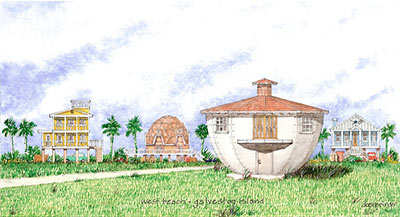
- Galveston: Watercolor artist Don Springer, who makes a habit of rendering area oddities, wants to know more about the Galveston Kettle House on the San Luis Pass between Pirates Beach and Pirates Beach West he painted a few weekends ago. “I know that it was not the radio station KUFO which once broadcasted from the foot of the Flagship (That flying saucer is now a house on West Beach).” He passes on a story he heard from “credible sources” that the half-water-tower turned house was the home of a landscaper who recently passed away, but asks, “Can you use your unlimited resourses, connections, and talent to determine the history of this landmark before it rolls off into the sunset?” Readers? He’s talking to you.
- Montrose: Chronicle tech guy Dwight Silverman wants to know what’s going into the building at 1721 Waugh, just south of the Commonwealth split; at about the same time, another Swamplot reader sends us this recent pic of what looks to be a refacing job on the building:
COMMENT OF THE DAY: MAKING HISTORY IN GALVESTON 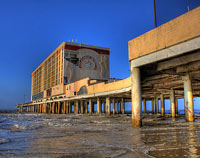 “what’s equally funny is that the sign on the [pier] now reads ‘[coming] soon: galveston’s historic pleasure pier’. i guess on this island, things are now considered historic even before they’re built.” [JC, commenting on Landry’s Kicking Galveston’s Flagship Hotel Off the Pier, for Amusement] Photo: Ellen Yeates
“what’s equally funny is that the sign on the [pier] now reads ‘[coming] soon: galveston’s historic pleasure pier’. i guess on this island, things are now considered historic even before they’re built.” [JC, commenting on Landry’s Kicking Galveston’s Flagship Hotel Off the Pier, for Amusement] Photo: Ellen Yeates
HAIKU OF THE DAY: AMUSEMENT PARK WEATHER Landry’s not on land, sell gale storm rides with dinner. OK, Fertitta? [houku, commenting on Landry’s Kicking Galveston’s Flagship Hotel Off the Pier, for Amusement]

First order of business for Tilman Fertitta, now that he’s finally succeeded in turning Landry’s Restaurants back into a private company under his control (the deal closes today): announcing the demolition of Galveston’s hobbled-on-a-pier Flagship Hotel. Actually, Landry’s officials jumped the gun slightly, showing plans for a large hotel-free amusement park on the 25th St. Pier site of the shuttered hotel to Galveston’s city council yesterday. In place of the Flagship — which was built a few years after Hurricane Carla hit the island in the early sixties — yep, you guessed it: There’s gonna be a Ferris wheel. Plus: a double-decker carousel and other attractions meant to vaguely resemble the amusement park originally on the pier when it was built in 1943.
CALCULATING DANGER IN GALVESTON The data miners behind the Neighborhood Scout website have declared a small but notable section of Galveston to be the 21st most dangerous neighborhood in the U.S. — and the second most dangerous in Texas (the top state honor goes to #15, an area near E. Lancaster Ave. in Ft. Worth). Working from secure offices in Rhode Island using the company’s “patented, patent-pending, exclusive or proprietary” data, Neighborhood Scout calculates residents of the area in Galveston from 19th to 26th streets between Broadway and Harborside (labeled the Church St. neighborhood) have a 1 in 11 chance of becoming a crime victim over a 1-year period. No, the risks of becoming a storm or flooding victim appear to have had no effect on the rankings. Included in that little hood: The heart of Galveston’s Strand Historic District. [Wallet Pop; details]
GALVESTON’S NEW RINSE-OFF NIGHTSPOT  A lawsuit will determine whether Scott Arnold can collect the remainder of the insurance money he expects for the loss of the famed Balinese Room to Hurricane Ike. In the meantime, the former owner of the waterside bar wanted to make sure his next nightspot would survive another big Galveston flood. So . . . is his new Granite Room, which opened on July 4th as part of the Voodoo Lounge complex at 26th and Mechanic streets, on an upper floor or something? Naaah. It’s mop-down friendly: “This building got nine feet of water during Ike,†he tells HBJ reporter Allison Wollam. “So I designed the club with granite and marble so that if it floods again, we can just hose everything down and be open again within a week or two.†[Houston Business Journal; previously on Swamplot] Photo: Granite Room
A lawsuit will determine whether Scott Arnold can collect the remainder of the insurance money he expects for the loss of the famed Balinese Room to Hurricane Ike. In the meantime, the former owner of the waterside bar wanted to make sure his next nightspot would survive another big Galveston flood. So . . . is his new Granite Room, which opened on July 4th as part of the Voodoo Lounge complex at 26th and Mechanic streets, on an upper floor or something? Naaah. It’s mop-down friendly: “This building got nine feet of water during Ike,†he tells HBJ reporter Allison Wollam. “So I designed the club with granite and marble so that if it floods again, we can just hose everything down and be open again within a week or two.†[Houston Business Journal; previously on Swamplot] Photo: Granite Room
THE POWER BALLS HAVE ARRIVED! Okay, fess up: Which one of you has been secretly transporting oil from the Deepwater Horizon gusher to our local beaches? The Coast Guard reported over the weekend that up to 5 gallons of dime- to ping-pong-ball-size tar balls collected from the surf along East Beach in Galveston and the Bolivar Peninsula’s Crystal Beach came from BP’s little offshore accident. But surely the little bugger-balls can’t have been trying to swim all the way back to headquarters? “[Coast Guard captain Marcus] Woodring said the condition of the tar balls didn’t look like they had drifted all the way from the Macondo well. They were ‘inconsistent with the weathering pattern that would be expected,’ he said. ‘To travel 400 miles is going to take a long time,’ during which the oil would be expected to break down. Officials were investigating whether the tar balls were from oil that clung to the hull of a ship passing through the BP oil slick or were from ballast water taken on by a ship in the oil slick zone and later dumped in Texas waters, Woodring said.” [Houston Chronicle]
GALVESTON TAR BALLS UNDISTURBED BY OIL SPILL “If oil from the spill reaches Texas, it will likely be in the form of tar balls, said Capt. Marcus Woodring, U.S. Coast Guard sector commander for Houston-Galveston. He said tar balls found along Texas shores so far have been analyzed and are not from the spill. Tar balls are common along the Gulf Coast because of minor oil spills and natural seepage, he said. As a precaution, floating barriers are already being placed in washout areas on the Bolivar Peninsula to protect the wetlands behind them, he said.” [Houston Chronicle]

